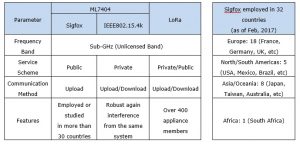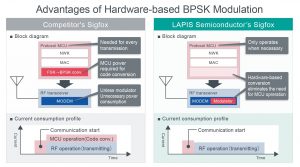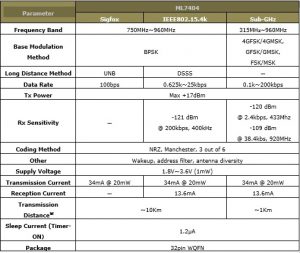Supports both Sigfox and IEEE802.15.4k standards and expands transmission range by more than 10 times for IoT equipment
ROHM Group company LAPIS Semiconductor has recently announced the availability of an RF LSI optimized for LPWA (Low Power Wide Area), which is expected to usher in a new area of wireless IoT communication.
The ML7404 is the first wireless communication LSI in the industry to feature LPWA dual-mode functionality, supporting both the Sigfox standard (subscription-based LPWA using unlicensed sub-GHz), which has been adopted in more than 30 countries and expanding in metropolitan areas including Japan, and the international protocol IEEE802.15.4K that is extremely robust against interference from the same system and has the capacity to cover more terminals under one network. This dual-mode capability enables use in a wide range of applications/specifications.
Communication modules containing this device will be released from partner companies to simplify the development of LPWA-compatible devices that contribute increased IoT adoption. In addition, the protocol stack for IEEE802.15.4k will be provided as open-source from our partner stack vendors.
In recent years, LPWA using the sub-GHz band (which is not subject to RF licensing) is attracting attention for IoT applications. However, because the specific communication protocol varies from one country/region to the next, as of yet no method has been standardized from among the diverse array of IoT networks currently in use.
LAPIS semiconductor has previously released wireless communication LSIs for sub-GHz specified low power radio base stations ahead of the competition, helping to achieve a smarter world through IoT. This time we developed an LPWA device that supports multiple methods, facilitating the early launch of IoT networks and the effective spread of applications and services.
Rohm will present ML7404 at European Utility Week (EUW) in Amsterdam.
The new LSI will be shown in Europe at the EUW in Amsterdam beginning of October. European Utility Week is the premier innovation and information platform connecting the smart utility community. The fair is focusing on grid optimisation, renewables, energy storage, smart metering, smart cities, smart homes as well as intelligent buildings, data management and IoT. More than 600 exhibitors are joinig the show. ROHM can be found in hall 1 at booth 1F1.
Key Features
- Supports dual LPWA modes (Sigfox and IEEE802.15.4k)
The ML7404 is a dual-mode LPWA wireless communication LSI compatible with both IEEE802.15.4k and the Sigfox standard utilized predominately in Europe.
- a) Compatible with Sigfox
Sigfox, a type of LPWA wireless communication system is currently being employed in more than 30 countries around the world.
- b) Supports IEE802.15.4k
The 802.15.4k standard defined by IEEE is characterized by DSSS based on orthogonal spreading codes and features high interference tolerance from the same system compared with other spread spectrum communication methods. Plus it can accommodate more terminals under the same network. This protocol utilizes the high reliability sub-GHz band that does not require a license.
- The industry’s first hardware-based BPSK modulation circuit for Sigfox contributes to lower set power consumptionSigfox uses the BPSK modulation method which is not employed by conventional sub-GHz communication. However, because standard Sigfox compliant LSIs do not support BPSK modulation, it is necessary to create BPSK symbol data utilizing control MCU software. Unfortunately, this requires that the control MCU be activated each time wireless communication is performed, resulting in unnecessary set power consumption. In contrast, the ML7404 integrates a BPSK modulation circuit that eliminates the need for the control MCU to operate (in the physical layer) during wireless communication, reducing system power consumption.The industry’s first hardware-based BPSK modulation circuit for Sigfox contributes to lower set power consumption
- Development support
An optional evaluation kit bundles sample programs (simple MAC) and various test scenarios, with reference module designs currently being prepared. In addition, full support is offered, including manuals and tools that can be downloaded from LAPIS’ website (registration required). And in the future, communication modules integrating the ML7404 along with low power protocol stacks for IEEE802.15.4k will be released from partner companies.
Specifications
※May vary depending on reference values, communication conditions, and the ambient environment























